Are you curious about how the majestic mountains and stunning rock formations around us are formed? How Are Rocks Eroded? Erosion, a powerful geological process, is the key. At rockscapes.net, we’ll delve into the fascinating world of rock erosion, uncovering the forces that shape our landscapes and how you can appreciate and even incorporate these natural processes into your own outdoor designs. Discover the secrets of landscape design, rock formations, and earth sculpting today.
1. What is Rock Erosion and How Does It Work?
Rock erosion is the process where rocks are worn away and transported by natural forces. It’s different from weathering, which only breaks down rocks without moving them. Erosion involves the removal of rock and soil debris by various agents, including gravity, wind, rain, rivers, oceans, and glaciers. This process is a crucial part of the rock cycle, constantly reshaping the Earth’s surface.
Rock erosion is a fascinating and complex process. Here’s a closer look at how it works:
-
Breaking Down Rocks: Erosion starts with the breakdown of rocks into smaller pieces. This can happen through physical weathering (like temperature changes causing rocks to crack) or chemical weathering (like acid rain dissolving rocks).
-
Transportation: Once the rocks are broken down, they need to be moved. This is where the different agents of erosion come in. Gravity can pull rocks downhill, wind can carry sand and dust particles, water can wash away soil and pebbles, and glaciers can grind down entire landscapes.
-
Deposition: Eventually, the eroded material comes to rest in a new location. This is called deposition. For example, rivers might deposit sediment at their mouths, creating deltas. Wind might deposit sand in dunes, and glaciers might leave behind piles of rocks and debris called moraines.
The rate of erosion depends on several factors, including the type of rock, the climate, and the slope of the land. Soft rocks like sandstone erode more easily than hard rocks like granite. Areas with heavy rainfall or strong winds experience more rapid erosion than drier, calmer areas. Steep slopes are more prone to erosion than flat lands.
Understanding how rock erosion works is essential for appreciating the dynamic nature of our planet. It also has practical implications for land management and construction. For example, engineers need to consider the potential for erosion when building roads, bridges, and buildings. Farmers need to use soil conservation practices to prevent erosion from damaging their land. By understanding the processes of rock erosion, we can better protect our environment and build sustainable communities.
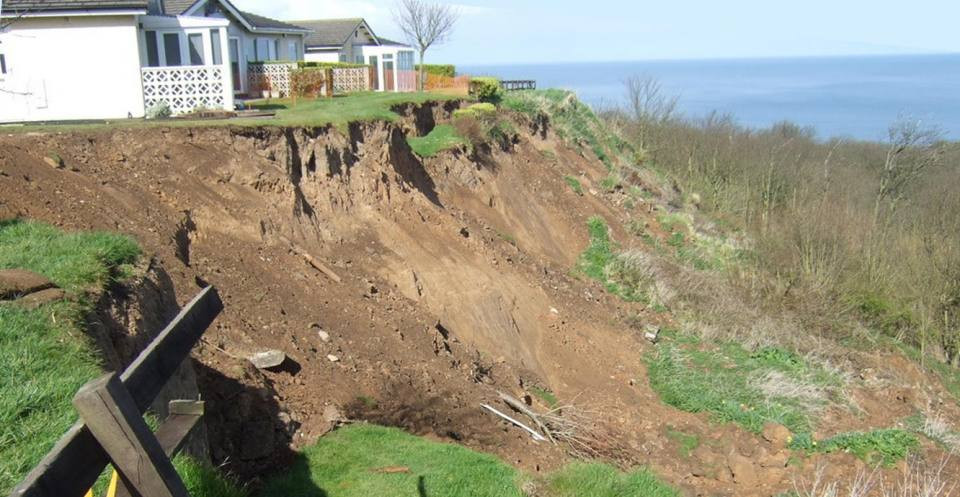 Landslide at Knipe Point, UK. The loose soil and rocks are sliding down the shore cliff because of gravitational erosion. BGS © UKRI.
Landslide at Knipe Point, UK. The loose soil and rocks are sliding down the shore cliff because of gravitational erosion. BGS © UKRI.
2. What are the Main Agents of Rock Erosion?
There are six main agents of rock erosion, each playing a unique role in shaping the Earth’s surface. Let’s explore each one:
2.1. Gravity: The Downward Pull
Gravity is a fundamental force that plays a significant role in rock erosion. Gravitational erosion happens when rocks and sediments move downhill due to gravity. This is often seen in landslides, where large amounts of soil and rock suddenly slide down a slope. Gravity also works in conjunction with other erosion agents, like glaciers and rivers, by moving weathered material to lower ground where they can be transported away.
Gravitational erosion is a powerful force that shapes landscapes and creates hazards. Here’s a closer look at how it works:
-
Landslides: Landslides are a dramatic example of gravitational erosion. They occur when the force of gravity overcomes the resistance of soil and rock, causing them to slide downhill rapidly. Landslides can be triggered by heavy rainfall, earthquakes, or human activities like deforestation.
-
Rockfalls: Rockfalls are similar to landslides, but they involve the free fall of rocks from cliffs or steep slopes. Rockfalls are often caused by weathering, which weakens the rock and makes it more susceptible to gravity.
-
Soil Creep: Soil creep is a slow, gradual form of gravitational erosion. It occurs when soil particles move slowly downhill due to gravity. Soil creep is often caused by freeze-thaw cycles, which expand and contract the soil, causing it to move slightly downhill.
-
Talus Slopes: Talus slopes are piles of rock debris that accumulate at the base of cliffs or steep slopes. They are formed by rockfalls and other forms of gravitational erosion.
Gravity is a constant force that affects all landscapes. Understanding how it works is essential for managing natural hazards and protecting infrastructure.
2.2. Wind: The Sculptor of Deserts
Wind erosion is a significant force, especially in arid and semi-arid regions. The wind picks up loose sand and dust particles and carries them away, a process called deflation. These airborne particles act like sandpaper, slowly wearing away at rock surfaces through abrasion. Over time, wind erosion can create unique landforms like mesas, buttes, and yardangs.
Wind erosion is a complex process influenced by various factors, including wind speed, vegetation cover, and soil type. Here’s a closer look at how it works:
-
Deflation: Deflation is the process of wind removing loose soil and sediment. This process is most effective in areas with little or no vegetation cover.
-
Abrasion: Abrasion is the process of wind-blown particles colliding with and wearing away rock surfaces. This process is most effective in areas with strong winds and abundant sand or dust.
-
Transportation: Wind can transport sediment over long distances. Fine particles like dust can be carried thousands of miles, while larger particles like sand are typically transported closer to the ground.
-
Deposition: Wind deposits sediment in various landforms, including dunes, loess deposits, and sand sheets. Dunes are mounds of sand that are formed by the accumulation of wind-blown sand. Loess deposits are blankets of silt that are formed by the accumulation of wind-blown dust. Sand sheets are flat, extensive areas covered with sand.
Wind erosion is a significant environmental problem in many parts of the world. It can lead to soil degradation, reduced crop yields, and air pollution. However, there are several ways to mitigate wind erosion, including planting vegetation, using windbreaks, and implementing soil conservation practices.
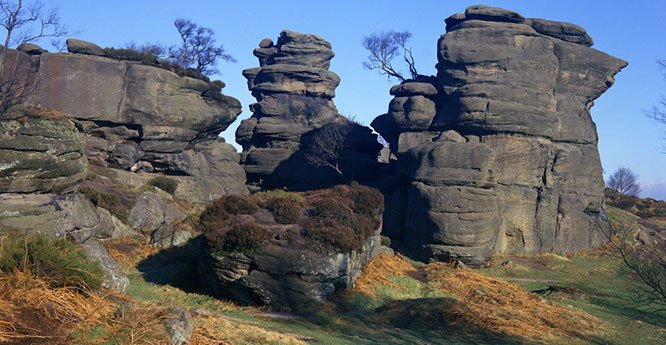 Brimham Rocks, North Yorkshire. These horizontally bedded sedimentary rocks show wind erosion. BGS © UKRI.
Brimham Rocks, North Yorkshire. These horizontally bedded sedimentary rocks show wind erosion. BGS © UKRI.
2.3. Rain: The Gentle Carver
Rain erosion, also known as rain-splash erosion, occurs when raindrops impact the ground, dislodging soil particles. While a single raindrop may seem insignificant, the cumulative effect of countless raindrops over time can be substantial. Heavy rainfall can also lead to gully erosion, where channels are carved into the landscape by flowing water.
Rain erosion is a significant environmental problem, especially in areas with steep slopes, poor vegetation cover, and intense rainfall. Here’s a closer look at how it works:
-
Rain-splash Erosion: Rain-splash erosion is the process of raindrops dislodging soil particles upon impact. This process is most effective in areas with bare soil.
-
Sheet Erosion: Sheet erosion is the removal of a thin layer of soil from the land surface by runoff water. This process is most effective in areas with gentle slopes and little vegetation cover.
-
Gully Erosion: Gully erosion is the formation of deep channels in the land surface by concentrated runoff water. This process is most effective in areas with steep slopes and erodible soils.
-
Rill Erosion: Rill erosion is the formation of small channels in the land surface by runoff water. These channels are smaller than gullies but larger than rain splashes.
Rain erosion can lead to soil degradation, reduced crop yields, and water pollution. However, there are several ways to mitigate rain erosion, including planting vegetation, using terraces, and implementing soil conservation practices.
2.4. Rivers: The Powerful Sculptors
Rivers are powerful agents of erosion, capable of carving deep valleys and transporting vast amounts of sediment. River erosion happens through hydraulic action (the force of water against the riverbanks), abrasion (the wearing away of rocks by sediment carried in the river), and solution (the dissolving of soluble rocks like limestone). Rivers also deposit sediment downstream, creating floodplains and deltas.
River erosion is a complex process influenced by various factors, including river flow, channel slope, and rock type. Here’s a closer look at how it works:
-
Hydraulic Action: Hydraulic action is the force of water against the riverbanks and bed. This force can erode rocks and soil, especially in areas with weak or fractured rocks.
-
Abrasion: Abrasion is the process of rocks and sediment carried by the river colliding with and wearing away the riverbanks and bed. This process is most effective in areas with strong currents and abundant sediment.
-
Solution: Solution is the dissolving of soluble rocks like limestone by the river water. This process is most effective in areas with acidic water.
-
Transportation: Rivers transport sediment downstream in various ways, including suspension, saltation, and traction. Suspension is the process of fine particles like silt and clay being carried in the water. Saltation is the process of sand grains bouncing along the riverbed. Traction is the process of large rocks and boulders being rolled or dragged along the riverbed.
-
Deposition: Rivers deposit sediment in various landforms, including floodplains, deltas, and alluvial fans. Floodplains are flat areas adjacent to the river channel that are periodically flooded. Deltas are landforms that are formed at the mouth of a river by the accumulation of sediment. Alluvial fans are fan-shaped deposits of sediment that are formed at the base of mountains.
River erosion is a natural process that shapes landscapes and creates fertile land. However, it can also be a destructive force, causing flooding, landslides, and erosion of riverbanks. Managing river erosion is essential for protecting communities and infrastructure.
 Rain gullies in Black Ven landslide, Lyme Regis, Dorset. BGS © UKRI.
Rain gullies in Black Ven landslide, Lyme Regis, Dorset. BGS © UKRI.
2.5. Oceans: The Coastal Reshapers
Oceans are relentless eroders of coastlines. Wave action is the primary force, pounding against cliffs and beaches, wearing them away over time. Ocean currents also play a role, transporting sediment and eroding shorelines. Coastal erosion can lead to dramatic cliff collapses and the loss of valuable land.
Ocean erosion is a complex process influenced by various factors, including wave height, tidal range, and rock type. Here’s a closer look at how it works:
-
Wave Action: Wave action is the primary force of ocean erosion. Waves crash against the coastline, exerting tremendous pressure on the rocks and soil. This pressure can erode rocks, especially in areas with weak or fractured rocks.
-
Hydraulic Action: Hydraulic action is the force of water being forced into cracks and crevices in the rocks. This force can widen the cracks and eventually break the rocks apart.
-
Abrasion: Abrasion is the process of rocks and sediment carried by the waves colliding with and wearing away the coastline. This process is most effective in areas with strong waves and abundant sediment.
-
Solution: Solution is the dissolving of soluble rocks like limestone by the ocean water. This process is most effective in areas with acidic water.
-
Transportation: Ocean currents transport sediment along the coastline. This sediment can be deposited in various landforms, including beaches, sandbars, and spits.
Ocean erosion is a natural process that shapes coastlines and creates unique landforms. However, it can also be a destructive force, causing coastal flooding, landslides, and erosion of beaches and cliffs. Managing ocean erosion is essential for protecting coastal communities and infrastructure.
2.6. Glaciers: The Slow Grinders
Glaciers are massive rivers of ice that slowly flow across the land. Glacial erosion is an incredibly powerful force, capable of grinding down mountains and carving deep valleys. Glaciers erode through abrasion (the scraping of rocks against the underlying surface) and plucking (the lifting and removal of rocks from the bedrock). As glaciers melt, they deposit sediment, creating distinctive landforms like moraines and eskers.
Glacial erosion is a complex process influenced by various factors, including ice thickness, flow rate, and rock type. Here’s a closer look at how it works:
-
Abrasion: Abrasion is the process of rocks and sediment embedded in the ice scraping against the underlying bedrock. This process is most effective in areas with thick ice and abundant sediment.
-
Plucking: Plucking is the process of ice freezing onto and lifting rocks from the bedrock. This process is most effective in areas with fractured rocks.
-
Transportation: Glaciers transport sediment over long distances. This sediment can be deposited in various landforms, including moraines, eskers, and drumlins. Moraines are ridges of sediment that are deposited at the edges of a glacier. Eskers are sinuous ridges of sediment that are deposited by meltwater streams flowing beneath the glacier. Drumlins are elongated hills of sediment that are aligned in the direction of ice flow.
Glacial erosion is a natural process that shapes landscapes and creates unique landforms. However, it can also be a destructive force, causing erosion of mountains and valleys. As glaciers melt due to climate change, they can also contribute to sea level rise.
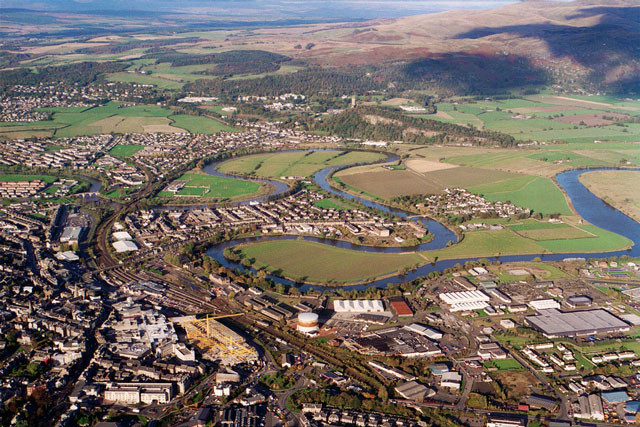 Aerial view of the meanders of the River Forth outside Stirling. BGS © UKRI.
Aerial view of the meanders of the River Forth outside Stirling. BGS © UKRI.
3. What Factors Influence the Rate of Rock Erosion?
The rate at which rocks erode is influenced by a complex interplay of factors. Understanding these factors is crucial for predicting erosion rates and managing its impact on landscapes. Here are some of the key factors:
- Rock Type: The type of rock is a primary determinant of its erodibility. Softer rocks like sandstone and shale erode much faster than harder rocks like granite and basalt. This is because softer rocks have lower resistance to weathering and abrasion.
- Climate: Climate plays a significant role in erosion rates. Areas with high rainfall and frequent freeze-thaw cycles tend to experience higher erosion rates. Rainfall increases the rate of chemical weathering and provides water for erosion by rivers and runoff. Freeze-thaw cycles cause rocks to expand and contract, weakening them and making them more susceptible to erosion.
- Topography: The slope of the land is another important factor. Steeper slopes are more prone to erosion because gravity pulls water and sediment downhill more forcefully.
- Vegetation Cover: Vegetation cover can significantly reduce erosion rates. Plant roots bind the soil together, making it more resistant to erosion by water and wind. Vegetation also intercepts rainfall, reducing the impact of raindrops on the soil surface.
- Human Activities: Human activities can have a significant impact on erosion rates. Deforestation, agriculture, and construction can remove vegetation cover and disturb the soil, increasing erosion rates. Conversely, soil conservation practices can reduce erosion rates.
According to research from Arizona State University’s School of Earth and Space Exploration, soil composition influences the rate of erosion, with sandy soils eroding more quickly than clay-rich soils.
Understanding these factors is essential for managing erosion and protecting our landscapes. By implementing appropriate land management practices, we can minimize the negative impacts of erosion and ensure the long-term sustainability of our environment.
4. How Does Rock Erosion Impact Landscapes and Ecosystems?
Rock erosion has profound impacts on landscapes and ecosystems. While it’s a natural process, it can have both beneficial and detrimental effects.
- Landform Creation: Erosion is responsible for creating many of the landscapes we admire, such as valleys, canyons, and coastlines. The Grand Canyon, for example, was carved by the Colorado River over millions of years.
- Soil Formation: Erosion breaks down rocks into smaller particles that contribute to soil formation. Soil is essential for plant growth and supports a wide range of ecosystems.
- Nutrient Cycling: Erosion releases nutrients from rocks and soil, making them available to plants and animals. This nutrient cycling is vital for maintaining healthy ecosystems.
- Sediment Transport: Erosion transports sediment from one place to another. This sediment can be deposited in rivers, lakes, and oceans, creating new habitats and altering existing ones.
- Water Quality: Erosion can degrade water quality by carrying sediment, nutrients, and pollutants into waterways. This can harm aquatic life and make water unsuitable for drinking or recreation.
- Landslides and Flooding: Erosion can increase the risk of landslides and flooding by destabilizing slopes and increasing runoff. These natural disasters can cause significant damage to property and infrastructure and can even result in loss of life.
- Habitat Loss: Erosion can lead to habitat loss by removing soil and vegetation. This can have a devastating impact on wildlife populations.
Rock erosion is a powerful force that shapes our planet. Understanding its impacts is essential for managing our environment and protecting our communities.
5. What Are Some Examples of Landforms Created by Rock Erosion?
Rock erosion is a creative force, sculpting a variety of stunning landforms across the globe. Here are a few notable examples:
- Canyons: Canyons are deep, narrow valleys carved by rivers over millions of years. The Grand Canyon in Arizona is a prime example, showcasing the immense power of water erosion.
- Valleys: Valleys are elongated depressions in the landscape, often formed by glacial or river erosion. Yosemite Valley in California is a classic example of a glacial valley.
- Sea Cliffs: Sea cliffs are steep rock faces that form along coastlines due to wave erosion. The White Cliffs of Dover in England are a dramatic example of sea cliff formation.
- Arches: Arches are natural rock formations with a curved opening, created by wind and water erosion. Arches National Park in Utah is famous for its numerous arches.
- Mesas and Buttes: Mesas and buttes are flat-topped hills or mountains with steep sides, formed by differential erosion. Mesa Verde National Park in Colorado is known for its mesa landscapes.
These are just a few examples of the many landforms created by rock erosion. Each landform tells a story about the forces that have shaped our planet over millions of years.
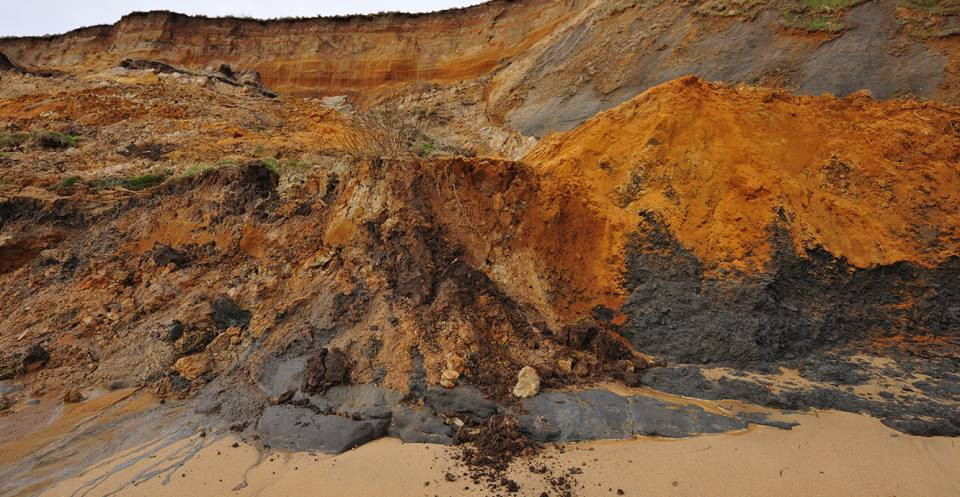 Coastal erosion at Newbiggin Cliff near Filey, North Yorkshire. The crashing of the waves loosens the rocks in the cliff face, making the land retreat. This sediment will eventually be picked up and redistributed by the sea. BGS © UKRI.
Coastal erosion at Newbiggin Cliff near Filey, North Yorkshire. The crashing of the waves loosens the rocks in the cliff face, making the land retreat. This sediment will eventually be picked up and redistributed by the sea. BGS © UKRI.
6. Can Rock Erosion Be Prevented or Controlled?
While rock erosion is a natural process, certain human activities can accelerate it. Fortunately, there are also ways to prevent or control erosion and mitigate its negative impacts.
- Vegetation Cover: Maintaining or restoring vegetation cover is one of the most effective ways to prevent erosion. Plant roots bind the soil together, making it more resistant to erosion by water and wind.
- Terracing: Terracing involves creating level platforms on slopes to reduce runoff and erosion. This technique is commonly used in agriculture to prevent soil loss.
- Contour Plowing: Contour plowing involves plowing along the contours of the land, rather than up and down the slope. This helps to slow down runoff and reduce erosion.
- Windbreaks: Windbreaks are rows of trees or shrubs that are planted to reduce wind speed and erosion. They are commonly used in agricultural areas to protect crops and soil.
- Sediment Traps: Sediment traps are structures that are designed to capture sediment before it can enter waterways. They are commonly used in construction sites and along roads.
- Coastal Protection: Coastal protection measures, such as seawalls and groins, can be used to protect shorelines from erosion by waves and currents.
According to the Environmental Protection Agency (EPA), implementing best management practices (BMPs) can significantly reduce erosion and sedimentation from construction sites.
By implementing these and other erosion control measures, we can minimize the negative impacts of erosion and protect our landscapes and ecosystems.
7. How is Rock Erosion Used in Landscape Design?
Believe it or not, rock erosion can be a source of inspiration for landscape design. By understanding how natural forces shape rocks, designers can create stunning and sustainable outdoor spaces.
- Rock Gardens: Rock gardens mimic natural rock outcroppings, showcasing the beauty of weathered rocks and plants that thrive in rocky environments.
- Water Features: Water features can be designed to simulate natural erosion processes, creating waterfalls, streams, and pools that resemble natural landscapes.
- Erosion Control: Landscape designers can use erosion control techniques, such as terracing and vegetation cover, to stabilize slopes and prevent soil loss in outdoor spaces.
- Natural Stone: Using natural stone in landscape design can add a sense of authenticity and connection to the natural environment. Weathered rocks and boulders can be incorporated into pathways, walls, and other landscape features.
At rockscapes.net, you’ll find a wealth of ideas and inspiration for incorporating rock erosion principles into your landscape design. From selecting the right types of rocks to designing sustainable drainage systems, we’ve got you covered.
8. What Types of Rocks are Most Susceptible to Erosion?
Not all rocks are created equal when it comes to erosion. Some rock types are more susceptible to weathering and erosion than others. Here’s a rundown of some of the most erodible rocks:
- Shale: Shale is a soft, sedimentary rock that is easily weathered and eroded. It is composed of clay minerals and is prone to breaking down into small pieces.
- Sandstone: Sandstone is another sedimentary rock that is relatively soft and erodible. It is composed of sand grains that are cemented together, but the cement can be weakened by weathering.
- Limestone: Limestone is a sedimentary rock that is composed of calcium carbonate. It is soluble in acidic water, making it susceptible to chemical weathering and erosion.
- Tuff: Tuff is a volcanic rock that is formed from volcanic ash. It is porous and relatively soft, making it easily eroded by wind and water.
Conversely, some of the most resistant rocks include:
- Granite: Granite is a hard, igneous rock that is very resistant to weathering and erosion.
- Basalt: Basalt is another hard, igneous rock that is also very resistant to weathering and erosion.
- Quartzite: Quartzite is a metamorphic rock that is formed from sandstone. It is very hard and resistant to weathering and erosion.
Understanding the erodibility of different rock types is essential for landscape design and construction. By selecting appropriate rock types for different applications, we can create landscapes that are both beautiful and durable.
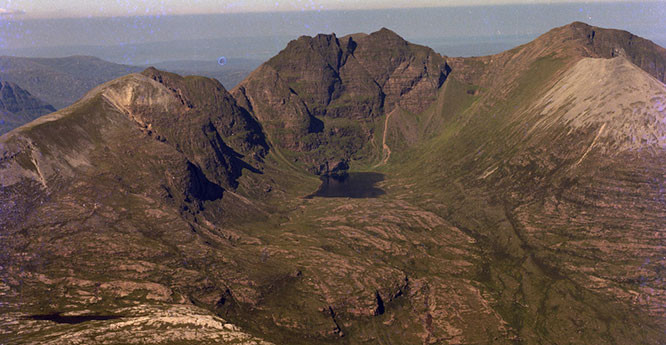 An Teallach, in Ross and Cromarty, is a mountain of Torridonian sandstone sculpted by glacial action. BGS © UKRI.
An Teallach, in Ross and Cromarty, is a mountain of Torridonian sandstone sculpted by glacial action. BGS © UKRI.
9. What Role Does Climate Change Play in Rock Erosion?
Climate change is exacerbating rock erosion in many parts of the world. Rising temperatures, changing precipitation patterns, and increased frequency of extreme weather events are all contributing to increased erosion rates.
- Increased Rainfall: In some areas, climate change is leading to increased rainfall, which can accelerate erosion by rivers and runoff.
- More Intense Storms: Climate change is also causing more intense storms, which can lead to increased coastal erosion and flooding.
- Thawing Permafrost: In Arctic regions, climate change is causing permafrost to thaw, which can lead to landslides and other forms of erosion.
- Sea Level Rise: Sea level rise is also contributing to coastal erosion, as higher water levels allow waves to reach further inland.
According to the Intergovernmental Panel on Climate Change (IPCC), climate change is projected to increase erosion rates in many parts of the world, with potentially significant impacts on landscapes, ecosystems, and human communities.
Addressing climate change is essential for mitigating its impacts on rock erosion and protecting our planet.
10. How Can I Learn More About Rock Erosion and Landscape Design?
If you’re eager to delve deeper into the world of rock erosion and landscape design, rockscapes.net is your ultimate resource.
- Explore our website: Discover a wealth of articles, guides, and inspiration for creating stunning and sustainable landscapes using natural stone and erosion control techniques.
- Contact our experts: Our team of experienced landscape designers and geologists is available to answer your questions and provide personalized advice.
- Visit our showroom: Come see our wide selection of natural stones and landscape materials in person.
- Follow us on social media: Stay up-to-date on the latest trends and ideas in landscape design and rock erosion.
At rockscapes.net, we’re passionate about helping you create the outdoor space of your dreams. Whether you’re a homeowner, landscape designer, or contractor, we have the resources and expertise you need to succeed. Don’t hesitate to reach out and let us help you bring your vision to life.
Address: 1151 S Forest Ave, Tempe, AZ 85281, United States
Phone: +1 (480) 965-9011
Website: rockscapes.net
FAQ: Understanding Rock Erosion
- What is the difference between erosion and weathering? Erosion involves the movement of weathered material, while weathering is the breakdown of rocks in place.
- What are the main causes of rock erosion? Gravity, wind, rain, rivers, oceans, and glaciers are the primary agents of rock erosion.
- How does rock erosion affect landscapes? It creates valleys, canyons, coastlines, and other landforms.
- Can humans prevent rock erosion? Yes, through vegetation cover, terracing, and other conservation methods.
- What types of rocks erode most easily? Shale, sandstone, and limestone are particularly susceptible to erosion.
- How does climate change influence rock erosion? Rising temperatures and changing precipitation patterns can accelerate erosion rates.
- Is rock erosion always a bad thing? No, it’s a natural process that shapes landscapes and creates soil, but accelerated erosion can be harmful.
- How can I use rock erosion in my landscape design? By creating rock gardens, water features, and using natural stone.
- Where can I find more information about rock erosion and landscape design? Visit rockscapes.net for a wealth of resources.
- How can I protect my property from rock erosion? Implement erosion control measures such as vegetation cover and terracing.
Are you ready to transform your outdoor space with the beauty of natural stone? Visit rockscapes.net today to explore our extensive collection of rocks, get inspired by our design ideas, and connect with our team of experts. Let us help you create a landscape that is both stunning and sustainable.